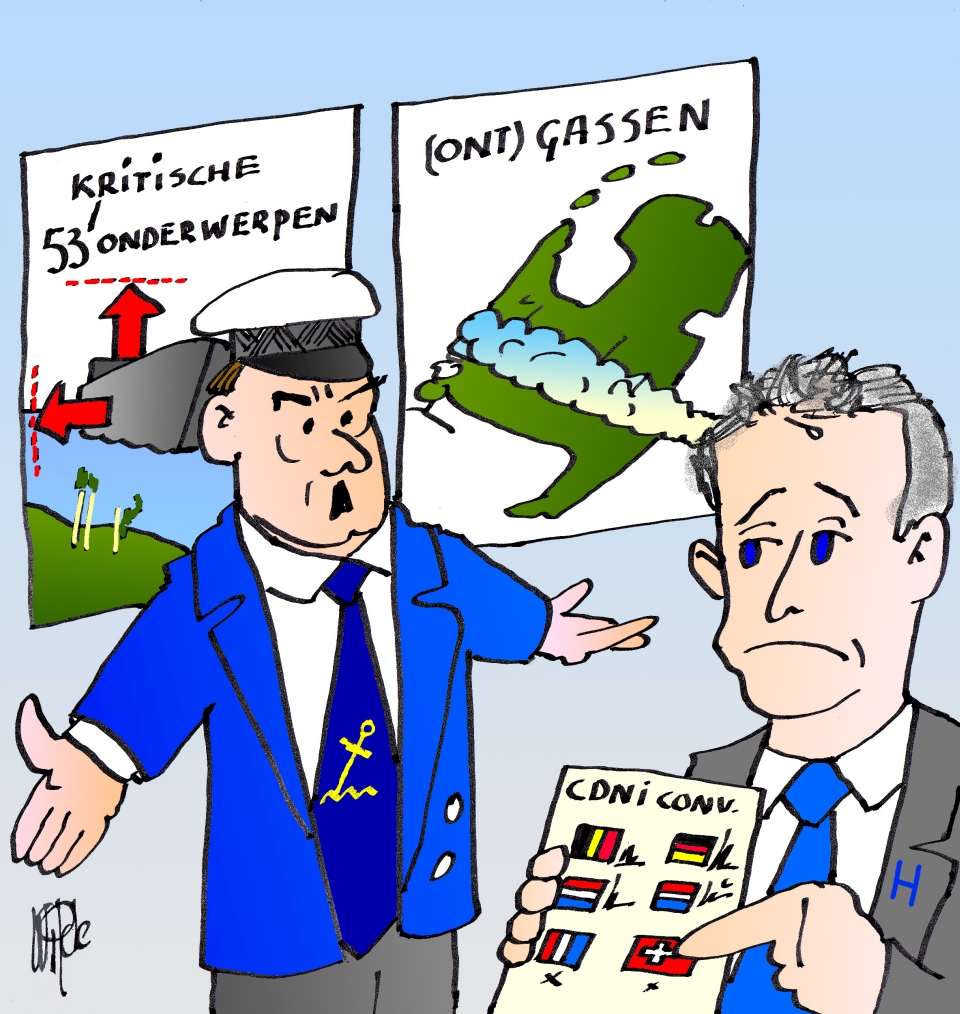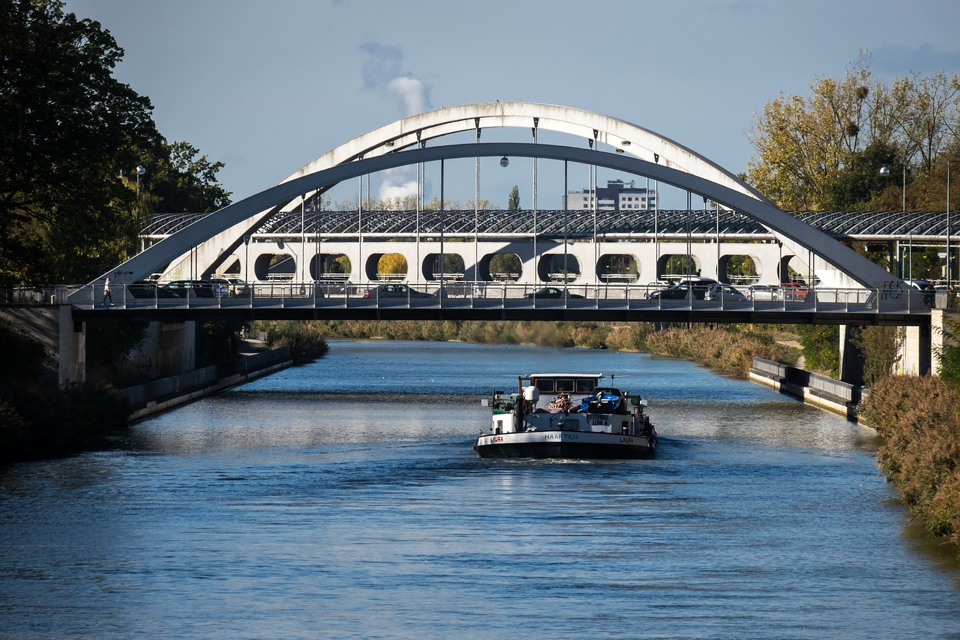Inland navigation is very much on the move. You could say, as there are ship names in inland navigation, “Panta Rhei” (everything flows). This statement comes from the Greek philosopher Heraclitus of Ephesus (circa 625-575 BC). With this statement, he was referring to his parable in which he relates that one can never cross the same river twice. Everything flows clearly indicates movement. This certainly applies to today’s inland navigation as well.
Every issue of SWZ|Maritime holds an opinion piece under the heading “Markets” about the maritime industry or a particular sector within it. Normally, it is written by SWZ|Maritime’s editor-in-chief Antoon Oosting, but for SWZ|Maritime’s April inland navigation special, this task was passed to our inland navigation specialist, Martin van Dijk.
The dynamics are strong. Transitions such as alternative fuels and propulsion and improved vessel types in view of multiple periods of extremely low water levels on European rivers are being considered at various levels. The inspections of small barges built before 1976 are also a sensitive issue that is of great concern to both barge operators and shippers. In addition, today’s tanker shipping has many consultations about degassing when in transit after unloading because there are insufficient shore degassing facilities. In short, a range of consultations and associated innovative thinking should provide perspective.
For a skipper-entrepreneur, what counts in the management of such issues is obviously the possible technical feasibility and the associated business case.
Also read: Northern Dutch shipyards compete for major fleet replacement
Inspections small inland navigation
According to the smaller inland shipping industry organisation Algemeene Schippers Vereeniging (ASV), seventy per cent of the total fleet in the Netherlands, some 3000 vessels, cannot meet the new and thus stricter inspection requirements. By 2035, all vessels up to 1500 tonnes (85 x 9.50 metres) built before 1976 must comply with new-build requirements.
Today, the inland vessel up to 1500 tonnes is a small vessel in CEMT class 4-A. The largest inland vessel in CEMT class 6-A is the Dutch tanker Vorstenbosch (147.15 x 22.90 metres, draught 5.40 metres, tonnage 13,317). The classification was determined by the Conférence Européenne des Ministres de Transport (hence the term CEMT class). The newbuilding requirements for inland vessels are defined in ES-TRIN. This abbreviation is the European standard setting the technical requirements for inland vessels and is mandatory for EU member states and the CCNR. It is regularly updated by CESNI.
The European committee for drawing up standards in the field of inland navigation (CESNI) and the Central Commission for Navigation on the Rhine (CCNR) in Strasbourg base themselves on these technical regulations. Before the CCNR was formally established in 1815, two essential aspects had already been agreed in the years before that it directly inherited: the establishment of an international inland navigation organisation and the fundamental principle of free navigation. The Mannheim Act of 17 October 1868 established the principle that there should be no more tolls for navigation on the Rhine and the member states represented in the CCNR could “jointly” adopt regulations (with any country being able to oppose a decision).
The power of the CCNR to deal with all aspects related to the “welfare” of navigation on the Rhine was confirmed. These include rules around the width of gangways, the height of accommodation and whether someone on board can walk around their bunk.
If nothing changes in the consultations, no vessel in the above segment will be allowed to sail on the Rhine from 2035. It is certainly not desirable for the ambition to encourage more waterborne transport that more vessels disappear from the market through scrapping.
Also read: ‘Maritime sector is good for our economy and jobs’
Hardship clause
The issue of newbuilding requirements has been the subject of many discussions, but this has not yet resulted in a solution satisfactory to all stakeholders. CCNR secretary general Lucia Luijten was a guest at Studio Schuttevaer on 10 March. She stated that skipper-entrepreneurs can invoke the hardship clause to get exemptions from unachievable technical requirements that are difficult, if not impossible, to achieve in older small vessels. The technical adjustments include a list of 53 critical issues.
It is a way of getting out from under the expiry of the transitional provisions. The inland navigation sector can use this clause to demonstrate that the new requirements are unfeasible and can thus get a waiver. The Netherlands would then have to convince the other four member states of the CCNR of this, based on sufficient data. A general pardon without exception applications, Luijten considers unlikely.
Trade association ASV, however, believes that claiming the hardship clause is not an option. Chairman Fluitsma is adamant: ‘We know from the past, that this clause is impossible. It’s such a difficult process and at any moment a party can say they won’t go through with it.’

Koninklijke Binnenvaart Nederland (KBN) is going to help its members invoke the hardship clause. Shippers’ organisation Evofenedex is deeply concerned about this issue: ‘As shippers, we cannot ignore the small vessel. As shippers, we really make the firm call to keep that small ship. 35 per cent of freight transport in the Netherlands goes by ship, towards Germany this even rises to fifty per cent.’
The Landelijke Vereniging tot Behoud van het Historisch Bedrijfsvaartuig (LVBHB, national association for the preservation of historic commercial vessels) has 2000 members, 1700 of whom have a functioning old vessel for pleasure boating and/or where people still live on board. The oldest vessel is from 1885 and this and next year a number of vessels will turn 100 years old. Next year, LVBHB will be celebrating its fiftieth anniversary and will sail through all the provinces with a Heritage Tour. LVBHB brings to the attention of governments, institutions and other conservation organisations the significance of this historic fleet.
Also read: Renewed prospects for ship repair after years of slump
Alternative fuels
Two barges are currently being prepared for hydrogen propulsion. Container ship MCS Maas will be the first to enter service as FPS Maas after a refit in May. Future Proof Shipping (FPS) has the ambition to make ten more inland vessels ready to use hydrogen by 2030. The dry cargo vessel Antonie is in the finishing phase as a new-build hull and will also have hydrogen on board. Completion of this vessel is scheduled for July. The market estimate is that by 2030, the cost of green hydrogen will be reduced by about fifty per cent.
Also read: Optimism about decarbonisation under threat of a China-US war
Degassing
Sometimes residual waste arises from cargo, either dry and/or wet product. This poses a real challenge to the environmentally friendly nature of inland navigation. Against this background, six states decided to establish international rules for the collection, delivery and reception of the ship’s waste. The Convention on the collection, deposit and reception of waste generated during navigation on the Rhine and other inland waterways (CDNI, Convention relative à la collecte, au dépôt et à la réception des Déchets survenant en Navigation rhénane et Intérieure) entered into force on 1 November 2009 in Belgium, Germany, France, Luxembourg, the Netherlands and Switzerland. Switzerland and France still need to ratify it.
Cargo tanks on barges sometimes need to be cleaned when a cargo of mineral or chemical products is changed. This is often necessary for quality reasons. One method of cleaning is to ventilate cargo tanks, often referred to as degassing. This is still regularly done to the outside air. Within the Netherlands, there is only one official shore-based degassing location. This is in Moerdijk at ATM, which belongs to the Renewi Group.
Yet, there are some five to eight mobile degassing units. However, the locations for these are not yet sufficiently available. Also, not all units have the required environmental permit yet. These have to be issued by provincial environmental departments.
In practice, degassing is done sailing when the tanker is empty. A fan then blows large quantities of air through the various cargo tanks and the gas vapours disappear into the open air via the detonation arrestors. This causes environmental nuisance for the crew, but also for citizens living along the waterway.
Both the industry and shippers want this to stop happening and, in anticipation of ratification of the convention, are asking the government to introduce a national degassing ban. Degassing with a product, depending on the vapour pressure of the product, takes between twelve and fifteen hours during transit for a 3000-tonne tanker. Within the logistics transport sector with liquid products, however, dedicated transport is already being pursued as much as possible. That means continuing to sail with the same product so that degassing is not necessary. Compatible transport is also being considered, i.e. products that are compatible in terms of safety and quality.
On 7 March, there was a House of Representatives roundtable discussion on degassing while in transit. The parties present were unanimous; Minister Harbers should ban degassing when in transit nationally as soon as possible, but the Minister does not yet want a national ban. First, Switzerland and France should ratify the international CDNI treaty, he says.
Bob Busser, director of the European Vapour Recovery Association (Evra, or the European degassing association), argues that waiting for ratification will harm the health of the Dutch population. If a degassing ban is imposed, degassing plants will follow.
Subscribers can read the April 2023 inland navigation special online in our Archive.
Also read: Is there still a future for LNG as a shipping fuel?








